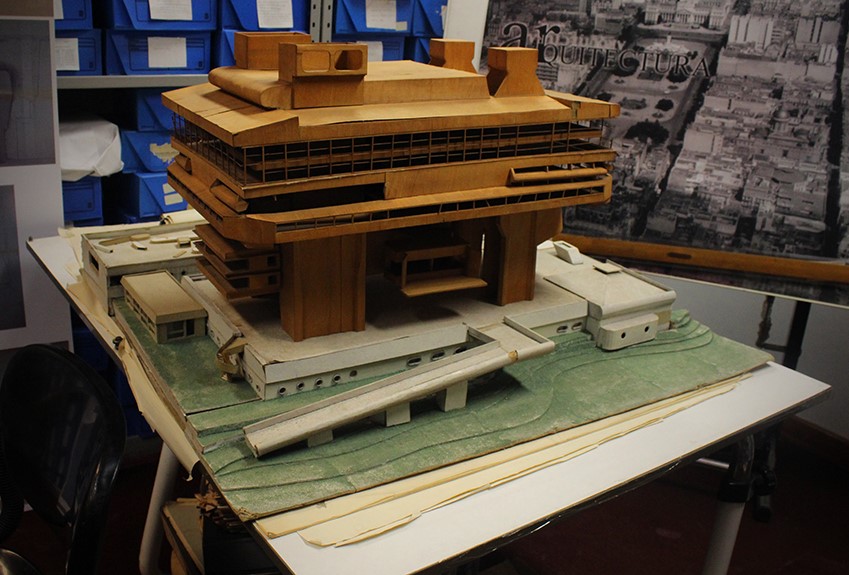Buenos Aires, 1962. The Project for the National Library
The architecture and the purpose
DOI:
https://doi.org/10.18861/ania.2022.12.1.3194Keywords:
Forma, función, diseño, desarrollismo, neobrutalismo, sistemas, finalidad, modernidad, monumentalidad, significaciónAbstract
The drama revealed by the end of the Second War, forced the reintroduction of the debate on architectural form, beyond a limited dispassionate and rational fiction of function. When function ceased to be the unitary pattern against which to compare modern buildings, critics and historians had to have new mirrors: monumentality, the production process, the user, the city, the form, the genius loci, the History, tradition or culture. In the following article the formulation of architectural images as catalysts of the concept of purpose in public architecture will be verified, as it was presented around the contest for the ultimate headquarters of the National Library in Buenos Aires in 1962, in whose architecture a feature of a manifest, redundant and dramatic character was superimposed by form to an efficient scheme and profitable organization.
Downloads
References
Argan, G.C. (1965) Proyecto y destino, Milán.
Banham, R. “The new brutalism” en Architectural Record. December, 1955
Banham, R. (1966) Brutalismo. Barcelona, Gustavo Gili.
Behne, A. (1923-25) Die Moderne Zweckbau. Boletín SCA n°48_enero 1963
Bonta, J.P. (1977) Sistemas de significación arquitectónica. Barcelona, Gustavo Gili.
Bullrich, F. (1957) Algunos problemas del diseño en Nueva Visión, N°9
Collins, P. (1977) Los ideales de la arquitectura moderna. 1750-1950. Barcelona, Gustavo Gili.
De Fusco, R. (1970) Arquitectura como “mass-médium”. Notas para una semiología arquitectónica. Buenos Aires, Anagrama.
De Zurko, E.R. (1958) La teoría del funcionalismo en la arquitectura. Buenos Aires, Nueva Visión.
Frampton, K. (1983) Historia Crítica de la Arquitectura Moderna. Barcelona, Gustavo Gili.
Groys, B. (2014) Volverse público: las transformaciones del arte en el ágora contemporánea. Buenos Aires, Caja Negra.
Heidegger, M. “Bauen, denken, wohnen” (1951).
Liernur, J.F. (1982) “Alpargatas, no. Libros, sí” en Materiales. Buenos Aires, La Escuelita
__________ (2004) “Testa, Clorindo” en Aliata, F. y Liernur, J.F. [Comp.] Diccionario de arquitectura en Argentina. Buenos Aires, AGEA
Plotquin, S. (2018): “Grandes luces: Vivienda y arquitectura en el ciclo de producción de la energía eléctrica” en Registros, Revista de Investigación Histórica - Vol. 14 Núm. 1: Arquitecturas de Estado: obras, infraestructura, empresas (1929-1973)
Rossi, A. (1966) L'architettura della città, Marsilio Editore, Padova, 1966
Shmidt, C. (2015) “Francisco Bullrich y la historia de la arquitectura. Anotaciones en tres momentos”. Vitruvia. Año 2 N°2
Sullivan, L. (1896) “The tall office building artistically considered”. Lippincott's Magazine, Vol. 339, p. 403-409.

Published
How to Cite
Issue
Section
License
Copyright (c) 2021 Silvio Plotquin

This work is licensed under a Creative Commons Attribution 4.0 International License.
The journal and its contents are licensed under the Creative Commons - Attribution 4.0 International License (CC BY 4.0). It is possible to copy, communicate and publicly distribute its content as long as the individual authors and the name of this publication are cited, as well as the publishing institution (Universidad ORT Uruguay).

